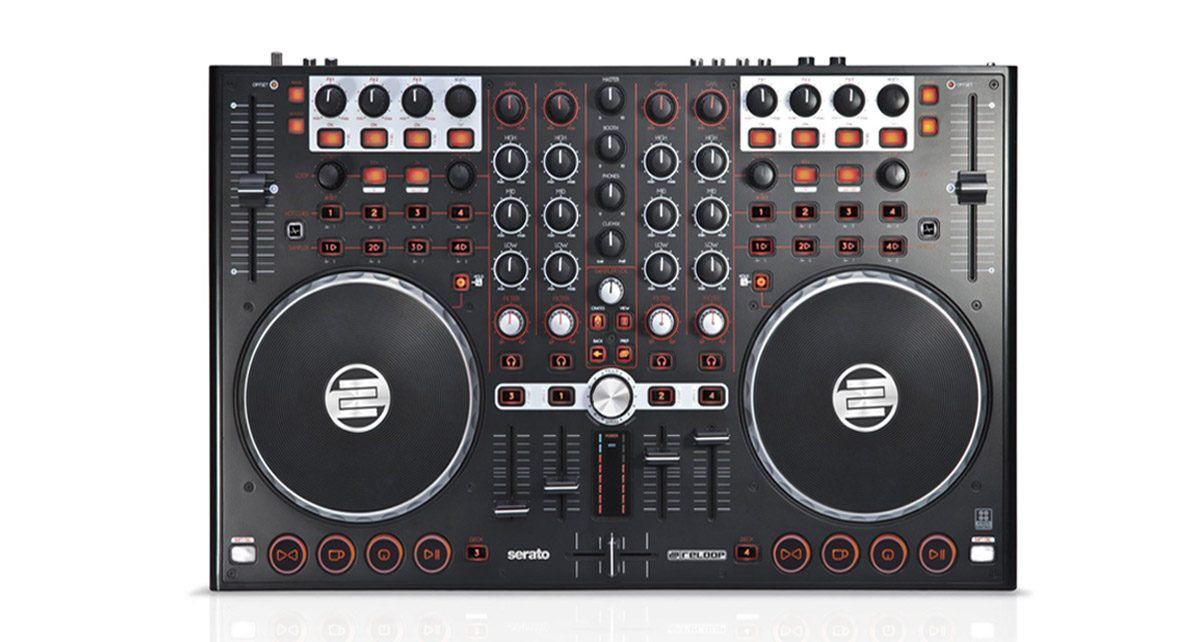The Lowdown
The Reloop Terminal Mix 4 is a great software controller, although it’s not a true standalone mixer and only has one external phono/line input. Its a good controller, and indeed, Reloop has nearly got a great controller on its hands here. The hardware is all there. Sure, it only has one external input, but frankly most users don’t own a pair of decks or a pair of CDJs anyway, and for plugging your iPod and / or a microphone in as a backup, or to MC an event, it’s plenty. We’re just not too keen on the watered down version of Serato that comes with it. It’s a four channel controller, so why should it ship with a two channel version of the software?
Video Review
First Impressions / Setting up
When Reloop released the Terminal Mix 2 and the Terminal Mix 4, it was yet another sign that Serato was planning what turned out to be Serato DJ software. After all, the Terminal Mix 4, especially, made little sense otherwise, as the supplied Serato software could only use two of its channels! Further to that, there were buttons that didn’t do stuff, and labels for non-functioning items. All of this gave the secret away somewhat.
Now that Serato DJ is with us, and the Terminal Mix 2 and Terminal Mix 4 are enabled to take the upgrade (plus, there’s a bundle on sale that actually includes Serato DJ in the box for the Terminal Mix 4, to save you upgrading the usually supplied Serato DJ Intro software), I thought I’d take a quick look at how the integration has worked, and what’s changed.
In Use
Making the switch
The first thing is that you have to upgrade the firmware of your unit in order for Serato DJ to work. Luckily, this is pretty simple stuff, and once done, you buy Serato DJ, activate the licence (licences work per computer), and you’re ready to go.
So what are the improvements? Well, one of my favourites is that using the little buttons near the rotary library encoder you can do additional things to what’s possible in Serato DJ Intro, and the best of these is the ability to jump through views (recording, FX, sampler…) to save you having to do this using the mouse / trackpad and pointer as before. It’s long been a bugbear with Serato DJ Intro and ITCH before it, and it’s good to see it fixed.
Audio-wise, the filter sounds better, and the FX – touted as one of Serato DJ’s big improvements – do indeed sound excellent, with a large degree of control. With some effects, there are two knobs and two buttons to switch and control various aspects of the effect as well as the usual wet/dry and on/off. The fourth knob and button per effects engine are – as before – beat multiplier and beat tap. The power of the new effects is somewhat diminished by the fact that you can’t stack them, and that there are only two – although they can be assigned to any channel, and to the master, which is a good point, especially for post-fader echoes and the like. Still, would have been good to see more power and flexibility here.
The sampler, for what there is, works well. Here the problem is not so much lack of features (although Serato DJ’s sampler doesn’t come close to the Remix Decks of Traktor for features, it is well implemented and has most of what most DJs would need), but rather the fact that you can’t control much from the unit itself. Back to the mouse, then, for quite a lot of stuff. Nonetheless, basic sample triggering (first three buttons of four per side) and sample bank switching (the fourth button) is there.
Other improvements? Fader start now works, the loop size now goes down to smaller and larger values, and also Smart Crates work, which they don’t in Serato DJ Intro (Smart Crates are a bit like auto playlists in iTunes). One omission to note, though, is that the intriguing “slicer” button still does nothing.
Conclusion
In short, this software upgrade means the Terminal Mix 4 is now the controller it was always meant to be. It’s solid, reliable, the jogwheel performance particularly is excellent, it sounds amazing, and for focusing on the basics of DJing, this controller / software partnership is a great choice. It falls down in the lack of integration in a few areas (particularly the sampler, although for the first time with Serato DJ you can now add external controllers if you wish to fix this), in the fact that the effect flexibility is limited, and that there are still buttons that do nothing, like the aforementioned Slicer.
Overall, though, it’s a fantastic partnership, and Serato DJ is a worthwhile upgrade for all Terminal Mix owners, but especially Terminal Mix 4 owners, because of course the really big pull is that you can now finally use all four channels of your hardware in software – which is, of course, the reason many people choose this one over the smaller Terminal Mix 2.


